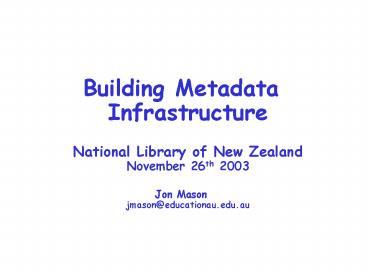Building Metadata Infrastructure - PowerPoint PPT Presentation
1 / 18
Title:
Building Metadata Infrastructure
Description:
from META tags to metadata schema. the XML revolution (don't forget HTML! ... page ranking via citations ( backlinks'), anchors', & proximity algorithms ... – PowerPoint PPT presentation
Number of Views:56
Avg rating:3.0/5.0
Title: Building Metadata Infrastructure
1
- Building Metadata Infrastructure
- National Library of New ZealandNovember 26th
2003 - Jon Mason jmason_at_educationau.edu.au
2
Presentation structure
- Who
- When
- What
- Why
- Where
- How
players stakeholders historical
context dimensions of metadata the bigger
picture case-studies the tricky details!
3
(No Transcript)
4
When Historical Context
- Growth of the information economy
- Organizing information on the Web
- directories, search engines, portals
- from META tags to metadata schema
- the XML revolution (dont forget HTML!)
- RDF the Semantic Web (next generation)
- Intersecting domains
- information services
- e-learning lifelong learning
- performance support
- human resource development
5
What Metadata Infrastructure
- Two characteristics
- Conceptual semantic
- Technical
- Information superhighway
- Metadata like the street signs
- Metadata standards like the road rules
- Accommodates content process
- Two main uses
- Machine-to-machine interoperability
- Human consumption
6
What Dimensions of Metadata
- Surface (e.g, web page last updated)
- Embedded
- as HTML META tags
- as suffixes (.doc, .html, .pdf, .ppt, jpeg, )
- as custom XML tags (metadata-rich markup)
- Detached
- in repositories of catalogued information
- RDF statements (relationship-rich)
- RSS channels
- Formally defined standards protocols
- Dublin Core (ANSI Z39.85)
- IEEE LOM (IEEE 1484.1-2002)
- METS (Metadata Encoding Transmission Standard)
7
What Dimensions of Metadata
an innovation in metadata handling page
ranking via citations (backlinks), anchors,
proximity algorithms
8
What Dimensions (METS)
- Descriptive (aboutness)
- Structural
- linking or organizing content chunks into
aggregates(printed books are relatively
self-organizing e-content can have infinitely
assigned structural maps) - Administrative
- e.g, managing catalogues
- metadata IP meta-metadata
- File Groups
- associating content chunks
- Behaviour
- rule-based
- METS - http//www.loc.gov/standards/mets/
9
Why
- Organizing managing information
- for subsequent discovery retrieval
- to enable data interchange
- separating content-structure-presentation
- Tool for the digital economy
- networked environment (diverse complex)
- economic value-chains based on value creation
rather than value extraction - Organizing knowledge
10
How Tasks
- Information modeling
- classification taxonomy development
- terminology vocabulary development
- data-typing
- referencing authoritative thesauri
- ontology development
- topic maps
- Description Abstract construction
- Keyword craft
- controlled vocabularies
- natural language
- Index creation
- Standard schema encodings
11
How Tool Development
- Many kinds of tools
- item level metadata assignment
- batch handling (assignment harvesting)
- retrospective assignment (Autonomy)
- topic map generation
- facilitate schema interoperability (SchemaLogic)
- taxonomy generators
- metadata extraction re-processing
- Content Management Systems
- RSS
- Principles
- automate where possible
- minimize human intervention
12
http//mapageweb.umontreal.ca/turner/meta/english/
13
Application Profiles
- Why
- - Local requirements are sometimes not fully
accommodated by standard schemas - How
- Extending or Abbreviating existing standards
- Mixing Matching standards namespaces
- However! Current practice suggests
interoperability an issue - Where
- SCHEMAS www.schemas-forum.org/registry/desire/app
profile.php3 - CORESwww.cores-eu.net/registry/schema/TLFwww.th
elearningfederation.edu.au/repo/cms2/tlf/published
/8519/Metadata_Application_Profile_1_3.pdf
14
Where Case-Studies
- EdNA Onlinehttp//www.edna.edu.au/search
- MERLOThttp//www.merlot.org/
- The Learning Federationhttp//www.thelearningfede
ration.edu.au - RDNhttp//www.rdn.ac.uk/
- EOE Foundation http//www.eoe.org/
15
Conceptual Challenges
- What is content?
- new data-types object-types constantly
appearing - Boundaries
- Where are the boundaries between content,
context, learning activities? - What are digital objects what are digital
collections? - Where are the boundaries between data,
information, knowledge? - When is a discovery service a directory service
( vice versa)? - Modeling knowledge
- extending the scope of metadata assignment use
16
Source Chris Blackall, ANU, 2003
17
Ongoing Questions
- How best to encode context?
- separate from content (eg., EML, EAD, EAC)
- embedded within descriptive metadata?
- include in Audience descriptions?
- include in Activity descriptions?
- Knowledge Management considerations
- Is completeness of description possible?
- How to achieve interoperability?
- DC, ERC, LOM HTML, XML, RDF,
- Semantic Web (semantics syntax)
- balancing generalist specific classification
18
- Questions?

